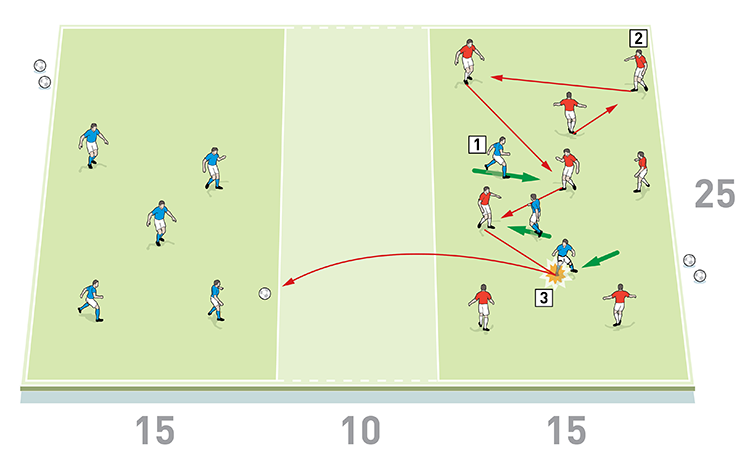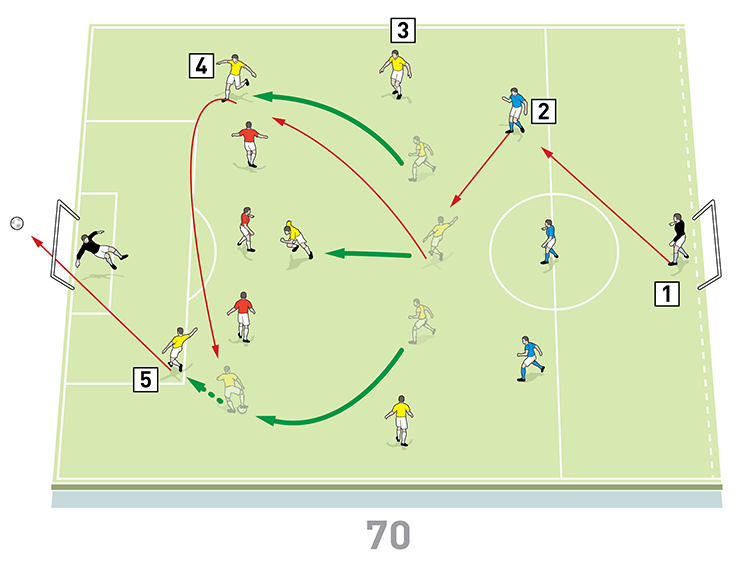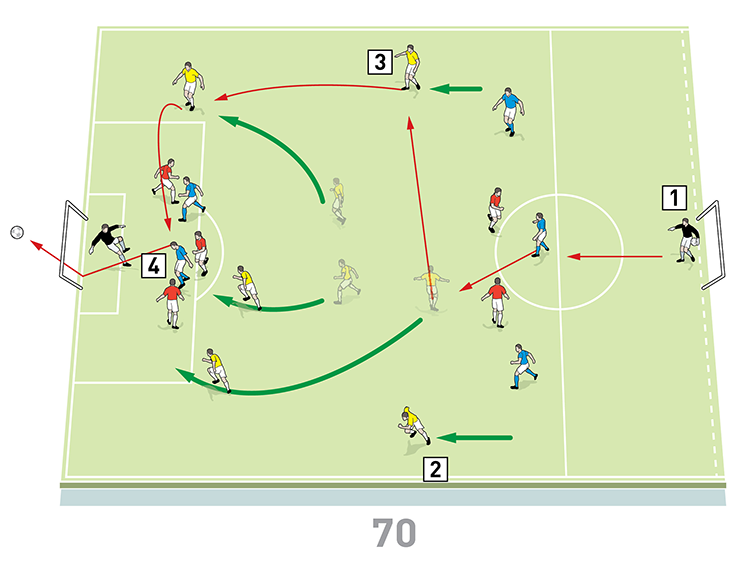




OUR BEST EVER OFFER - SAVE £100/$100
JOIN THE WORLD'S LEADING PROFESSIONAL DEVELOPMENT PROGRAMME
- 12 months membership of Elite Soccer
- Print copy of Elite Player & Coach Development
- Print copy of The Training Ground
Shaping a 3-5-2 formation
This training session is about maximising the full potential of the 3-5-2 system, which was very much in vogue in the 1990s. The formation has been utilised by successful German club sides, such as 1997 Champions League winners, Borussia Dortmund, and it was employed by the Germany team that won Euro 96 under Berti Vogts. More recently it was used by Gareth Southgate’s England team at the 2018 World Cup.
| Area | Up to two third of pitch |
| Equipment | Balls, bibs, cones, 2 full size goals |
| No. of Players | Up to 16 players + 2 goalkeepers |
| Session Time |
Changing boxes: 20mins, Shaping a team 8v3: 20mins, Shaping a team 10v5: 40mins |
This training session is about maximising the full potential of the 3-5-2 system, which was very much in vogue in the 1990s. The formation has been utilised by successful German club sides, such as 1997 Champions League winners, Borussia Dortmund, and it was employed by the Germany team that won Euro 96 under Berti Vogts. More recently it was used by Gareth Southgate’s England team at the 2018 World Cup.
This 3-5-2 system facilitates a training set-up of a very functional nature. When preparing a team, it is a much more preferable structure than ‘shadow play’, which is not particularly liked by players, no matter how efficiently it is organised.
This session would be used fairly regularly in pre-season and several times a week during the season. It is ideal preparation the day before a match, as offensive and defensive set-pieces are reinforced within the session.
What do I get the players to do?
Changing boxes
We set up two 25x15-yard boxes side by side but separated by a 10-yard gap. We’re using 16 players split into two teams of eight. One team begins in each box. We start the practice by getting players to familiarise themselves with the playing area, organising a passing session with a ball in each box.
After the players are warmed up, one ball is removed and three defending players are sent from the box without a ball to the opposition’s box. The team of eight pass under pressure from the three defenders. If the defenders win possession, or if the ball is played outside the area, then the ball is transferred across to the five remaining players in the other box, as shown [1a].
1a

2. The reds pass under pressure, trying to keep possession
3. If the blues win the ball, they transfer it to their team mates in the other box
The five players start to pass the ball in their area and are quickly rejoined by their three defenders. Three opposition defenders also enter the box, as shown [1b], and they press and try to win the ball back.
1b

2. The three blue defenders follow the ball back into their original box to rejoin their team mates in passing
3. Three red defenders also follow the ball, pressing to win possession when they reach the blue box
To enable the new possession team to establish composure on the ball, we sometimes get the opposition defenders to do three shuttles between the boxes before they can attempt to win the ball back.
How do I progress the session?
Shaping a team 8v3
To progress the session we introduce a big overload in favour of the team in possession. We set up on two third of a pitch, with a full size goal and a goalkeeper at each end. We’re using 11 outfield players, with three players defending each end and five midfielders in the centre who attack each goal in turn. It’s an 8v3 game, so the five midfielders join one set of defenders when they are in possession and attack the other set, as shown [2a].
2a

2. The yellow midfielders combine to attack the blue defenders
3. Once the attacking team has scored, or if the ball is dead or there has been a turnover, the five yellow midfielders turn to attack the reds at the other end
Once the attacking team has scored, or if the ball has been saved or if there has been a turnover of possession, the five midfielders join the other set of defenders and attack in the opposite direction, as shown [2b]. The absence of strikers is a deliberate attempt to get goals from the midfield players.
2b

2. The blue defenders now join with the yellow midfielders to attack the other end
3. The wing backs should not push into the final third
4. The inside midfielders push into the final third if width is needed
5. Once the ball is dead, the five yellow midfielders turn ready to attack the other end again
Play starts and restarts from the goalkeeper. We play for 20 minutes.
Shaping a team 10v5
This progression works on the same principles as the previous activity, but sees the introduction of strikers. Each unit of three defenders is given two strikers, who combine with the five midfielders to attack the defenders at the other end, as shown [3a]. Again, when the ball has gone dead, the five midfielders turn and join with the three defenders and two strikers of the other team to attack the opposite end, as shown [3b]. Play continues like this in waves.
3a

2. The yellow midfielders combine with the two red strikers to attack the blue defenders at the other end
3. Once the attacking team has scored, or the ball has gone dead, the five yellow midfielders turn ready to attack the other end
3b

2. The five yellow midfielders now join with the three blue defenders and the two blue strikers to attack the other end in a new 10v5
3. The wing back plays the ball up to the inner midfielder who fills the wide attacking role and crosses
4. When a goal is scored, or if the ball is dead, the five yellow midfielders turn ready to attack the other end again
We play for 40 minutes, or for as long as is required.
What are the key things to look out for?
There are many basic tactical things to consider. The configuration of the three central defenders is key and you should decide whether they defend zonally or man mark.
The shape of the midfield five is also important – one should sit deep and your wing backs should not advance too far into the front third, as it would be impossible to cover the entire wing for 90 minutes in a match. It should be the inner midfield players who makes the wide forward runs, not the wing backs.
The 3-5-2 structure has proved successful against other formations. However, careful scrutiny of the system in action reveals the 3-5-2 is deficient defensively when it is outnumbered in the wide areas. Each wing back has to compete with the two wide players of the opposition, unless suitable provision is made. Therefore the strikers have vitally important defensive duties to perform. On losing possession they are immediately required to defend the wide areas to shut off the opposition full backs. This early action will leave the centre backs, who over the years have been less comfortable on the ball, free to take possession.
What are the typical mistakes players might make and how do I avoid them?
Sometimes the back three can be indecisive about their responsibilities. We would instruct one of the defenders to move to the ball and the other two to sit square behind. For instance, the defender in the zone of the receiving player marks tight while the other two cover behind, or one defender attacks a high ball and makes the challenge while the other two offer protection.
The strikers can be lazy when the team is out of possession and they must remember their defensive responsibilities when necessary, normally pressing high and wide when the opposing goalkeeper distributes ball.
How would you put this in a game situation?
The 8v3 game is a small sided version of the exercise which should reinforce what is required and replicates the game situation very well.
The addition of another five opposition midfield players to the 10v5 game would complete two full teams, with only the defensive responsibilities of the middle five remaining to be instructed – the wing backs would need to be shown how to retreat to form a five-man defence and the middle three defenders are taught to move as a unit to the side of the ball.
Related Files
Editor's Picks
Attacking transitions
Deep runs in the final third
Using the goalkeeper in build-up play
Intensive boxes drill with goals
Penetrating the final third
Creating and finishing
My philosophy
Pressing initiation
Compact team movement
Coaches' Testimonials

Alan Pardew

Arsène Wenger

Brendan Rodgers

Carlos Carvalhal

José Mourinho

Jürgen Klopp

Pep Guardiola

Roy Hodgson

Sir Alex Ferguson

Steven Gerrard
Coaches' Testimonials

Gerald Kearney, Downtown Las Vegas Soccer Club

Paul Butler, Florida, USA

Rick Shields, Springboro, USA

Tony Green, Pierrefonds Titans, Quebec, Canada
Join the world's leading coaches and managers and discover for yourself one of the best kept secrets in coaching. No other training tool on the planet is written or read by the calibre of names you’ll find in Elite Soccer.
In a recent survey 92% of subscribers said Elite Soccer makes them more confident, 89% said it makes them a more effective coach and 91% said it makes them more inspired.
Get Monthly Inspiration
All the latest techniques and approaches
Since 2010 Elite Soccer has given subscribers exclusive insight into the training ground practices of the world’s best coaches. Published in partnership with the League Managers Association we have unparalleled access to the leading lights in the English leagues, as well as a host of international managers.
Elite Soccer exclusively features sessions written by the coaches themselves. There are no observed sessions and no sessions “in the style of”, just first-hand advice delivered direct to you from the coach.







